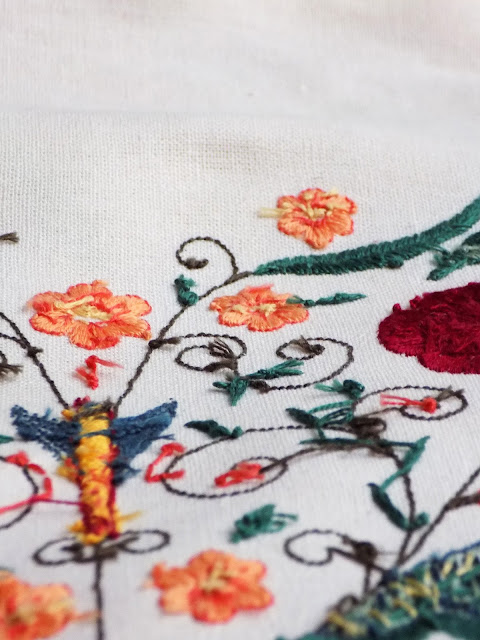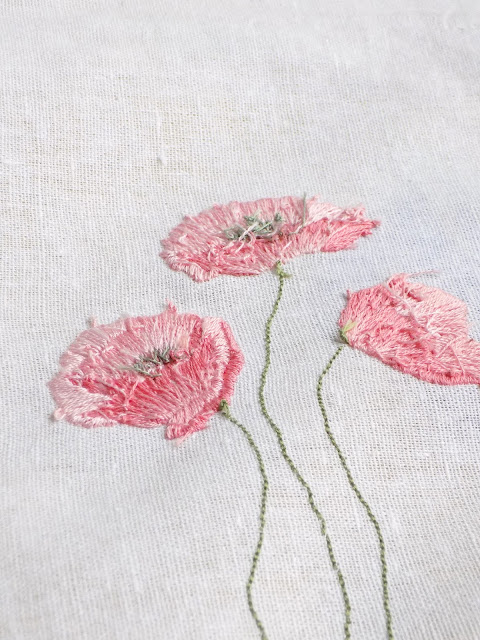Let's talk about the backside of hand embroidery and the “revolution” that is taking place right now. If you are a beginner in this craft, you may not know about how much of a stumbling block it used to always be in its world. If you are experienced, you probably watch the changes, contemplating on what effect they are going to bring.
But the fact is: with the new generation of stitchers the attitude to the backside of hand embroidery is undergoing massive changes. So, how did the “messy” backside turn from something disgraceful to something artful? What exactly is the role of the new generation in our craft?
HOW IT WAS IN THE PAST
Back in the days, the quality of hand embroidery was assessed not only by the look of it on the front side, but also by how it looks on the backside. It had to be neat and tidy, without bumps, lumps, without thread ends peeking out here and there.
The “perfection” was achieved when the front side didn't differ much from the backside. Of course, with some stitches it is hardly manageable, but there actually exist such stitches as “double side satin stitch” and others which indeed can grant this effect. Well, embroiderers of this school have their secrets ;)
But in short, that was the true pride of hand embroiderers just a while ago – to have the backside just as perfect as the front side. And they paid attention to the backside no less (and maybe even more) than to the actual “face” of the piece. This is what “excellence” of hand embroidery was mostly about – the perfect technique and skillful managing of thread on both sides.
(No wonder, knots were pretty much hated by some stitchers because of their clumsy look!)
WHAT IS CHANGING?
You may have noticed, how in the world of art and painting the expressionism and passion are taking over for technique. I will admit that I'm not a specialist in this area, but even I, with my limited knowledge, can see this tendency with the naked eye. The masterpieces of the past were mostly realistic and had barely noticeable brush strokes. Right now it is about being bold and maybe even a bit reckless both in using your brush and paint.
I see the similar tide in hand embroidery. The new generation of stitchers doesn't really care about the bumps and excesses of thread on the backside. Rather, they actually turn it into the embodiment of their passion and zeal as they stitch. The “messier” the backside is, the more artful it is. Bring in more knots, more thread, more everything! The more thread there is, covering almost all the surface of the backside, the more it “speaks” of the process of stitching. The more explicitly it tells a story. The more revealing it is of the artist's indentity.
You can even see the parallel between the bold thick brush strokes and the bold stitches using thick thread, which is quite popular nowadays.
MAKING THE SLOPPY BACKSIDE STITCHER'S PRIDE
I sincerely find this modern tendency one of the most intriguing in hand embroidery. Remember what I said about the past? Embroiderers back then would be proud of their backside only if it was perfectly neat. If it wasn't perfectly clean, they would rather hide it, because they would only feel ashamed if anyone saw. The new generation, however, takes pride in the messy backside. Basically, they are the modern rebels of hand embroidery!
WHERE DO YOU STAND?
Honestly speaking, I'm still on the borderline between these two generations. Despite being 25 years old, I can't refer to myself as a representative of the “rebellious” new generation, but I certainly find the new tide they create a very interesting one and I'm grateful to them for many things (more on that below).
I also can't call myself the follower of the “old school”. Although I really respect the embroiderers with the traditional approach and their aspiration for tidiness and neatness of the backside, and how inventive and cunning they are at making the process of stitching “invisible” on the backside!
But as for me... I guess I'm just practical about it? I don't strive to have a perfectly clean backside which could set in awe the lovers of technique. Especially since I tend to frame my pieces, so hardly anyone would see the backside of my embroidery anyway. Some may say, that making the backside beautiful and neat is for yourself and it is something to be proud about even when no one sees. But again, I'm a practical person. I would rather save my nerves and cut the attention I pay to the backside to devote more of myself to the front of it.
So, what I usually worry about is that my thread would not show through the fine fabric. This is my biggest concern when I stitch!
If we talk about knots, then I use them pretty often – but mostly when I use 1 or 2 strands of floss in the needle. Otherwise, they turn out too big and create these odious bumps which cause surface irregularities when you mount the piece. However, some stitchers cleverly minimize this problem by using embroidery hoops instead of frames ;) This way there is a free space between the backside and the wall, so bumps and lumps are not to be feared.
So, as you see, my fears are mostly about practical things connected with framing the piece.
WHAT BENEFITS DO THE CHANGES BRING? AND FOR WHOM?
I wonder, though, how much the image of hand embroidery and the role of the backside changed in the minds of people not related to this craft? When my relatives look at the backside of my embroidery they compliment me being amused at how clean it is. Although I know very well that it is far from perfection. So, as for now, I guess the “clean backside” is still something that is appreciated in the minds of other people. But the standards of what they would call neat are lower than it would be in the past.
I think the main recipients of the changes the new generation brings are us, stitchers. It's as if they tell us “Don't be ashamed of yourself and your process of stitching”. Because let's face it – the backside of our embroidery – is our weakness. Our vulnerability.
Revealing the backside of your embroidery, while knowing that it is not perfect, is like getting naked in front of the crowd.
It is embarrassing. You expect critique and inspection on all of your imperfections. Don't know about you, but this is how I feel. Exactly as if showing my own imperfections, not just the ones of my stitching.
So what is the main benefit of what I call "the new tide"? On my part, I can see that my self-confidence is being raised by it! That's why, willing to feel a bit rebellious (young and wild, haha!) I decided to include the images of the backside of some of my works! These are my imperfections!
How do you feel about the backside issue? What do you think about the tide that comes with the new generation? Are you one of the “rebels” of today hand embroidery or do you see yourself as the follower of “traditional” approach?

















Hello Amina, I've just discovered your blog as I've searched for information about ribbon work. I appreciate your style and candor. You do exquisite work with such a kind and fun attitude. Thank your for sharing.
ReplyDeleteI have a question for you. I'm sometimes to practical and if I don't have a purpose for a project I wonder why I should sew just for fun? What would I do with all that stuff? You can only give your friends and family so much. You can only hang so much on the walls! I love to embroider and other things but my block is being to impractical! :) Help:) Thanks for your thoughts.
Hi!
ReplyDeleteYou know, I have an idea, it is something I myself also want to try in the future. Try googling "embroidery sampler book" and click on the "images" tab. There will be lots of pictures for your inspiration and you can see even more on Pinterest.
So, the concept is to make an artbook out of your embroidery. It can include stitches samplers, or just pretty embroidery that you otherwise don't feel like framing, gifting or using in any other way. It can become a page in your embroidery book.
I like this idea because usually when we work some embroidery, it is being done on the background of some life events, some memories. And it becomes intertwined together. So when you will be paging through your embroidery artbook later you are likely to remember "ah, I was working on this when *this* happened", and I think it is kind of... precious :) You can include there collages, applique, some textile art. You can make pages out of fabric scraps or embroidered works themselves, or you can take some sturdy paper and use sewing machine to stitch your works down to the pages. There are many options :)
Here are some links for inspiration and a couple of tutorials:
https://m.blog.naver.com/626chk/221184868990
http://blog.carimateo.com/louise-bourgeoise-1911-2010/
http://bleuhortensia.canalblog.com/archives/2010/09/10/18886998.html
http://threadandthrift.blogspot.com/2014/05/blue-book.html?m=0
http://faithgracecrafts.blogspot.com/2014/04/tutorial-for-lace-book.html?m=1
https://makinghandmadebooks.blogspot.com/2011/04/cloth-book.html